

Compact Muon Solenoid
LHC, CERN
| CMS-PAS-EXO-16-046 | ||
| Search for new physics with dijet angular distributions in proton-proton collisions at $\sqrt{s}= $ 13 TeV and constraints on dark matter and other models | ||
| CMS Collaboration | ||
| July 2017 | ||
| Abstract: A search is presented for new physics using measurements of dijet angular distributions from proton-proton collisions at $\sqrt{s}= $ 13 TeV, constraining models of quark contact interactions, extra spatial dimensions, quantum black holes, and dark matter. The data collected with the CMS detector at the LHC correspond to an integrated luminosity of 35.9 fb$^{-1}$. The measured distributions are found to be in agreement with predictions from perturbative quantum chromodynamics (QCD) that include electroweak corrections. In a benchmark model, valid to next-to-leading order in QCD, in which only left-handed quarks participate, contact interactions are excluded up to a scale of 13.1 and 17.4 TeV for destructive or constructive interference, respectively. The most stringent lower limits to date are set on the scale of graviton exchange. In the Giudice-Rattazzi-Wells convention, virtual graviton exchange is excluded up to a scale of 10.6 TeV at 95% confidence. The production of quantum black holes is excluded for masses below 8.3 and 6.0 TeV, depending on the model. Vector and axial-vector mediators in a simplified model of interactions between quarks and dark matter particles with quark coupling $g_{\text{q}} = 1.0$, dark matter coupling $g_{\text{DM}} = 1.0$, and masses between 2.5 and 5.0 TeV are excluded. | ||
|
Links:
CDS record (PDF) ;
inSPIRE record ;
CADI line (restricted) ;
These preliminary results are superseded in this paper, EPJC 78 (2018) 789. The superseded preliminary plots can be found here. |
||
| Figures & Tables | Summary | Additional Figures | References | CMS Publications |
|---|
| Figures | |
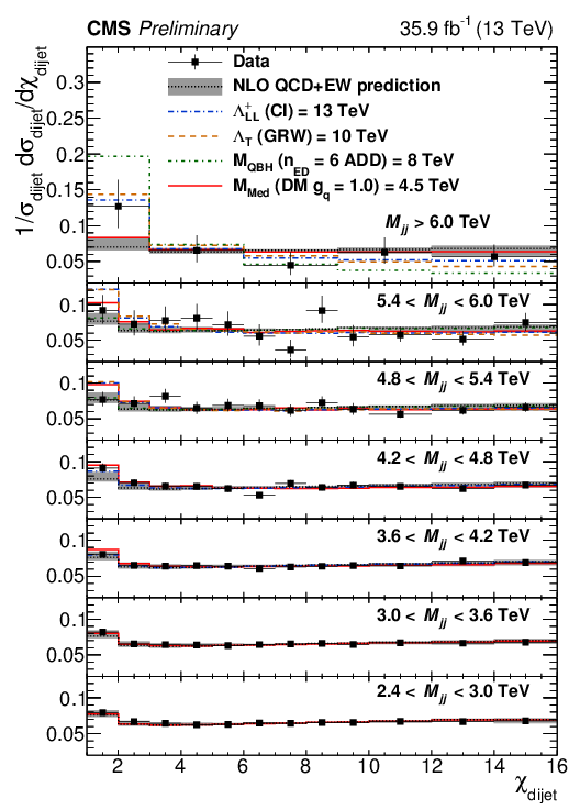
png pdf |
Figure 1:
Normalized $ {\chi _{\text {dijet}}} $ distributions shown for the unfolded data compared to NLO predictions (black dotted line). The error bars represent statistical and experimental systematic uncertainties combined in quadrature. Theoretical uncertainties are indicated as gray bands. Also shown are the predictions for QCD+CI with $\Lambda _{\mathrm {LL}}^{+}= $ 13 TeV (blue dashed-dotted lines), QCD+ADD with $\Lambda _{\mathrm {T}}\ (\mathrm {GRW})\ =$ 10 TeV (orange dashed lines), QCD+QBH with $n_{\mathrm {ED}}= $ 6 and $M_{\mathrm {QBH}}= $ 8 TeV (green dashed-dotted lines), and QCD+DM with $M_{\mathrm {Med}} = $ 4.5TeV and $g_{\text {q}} =1.0$ (red solid lines). |
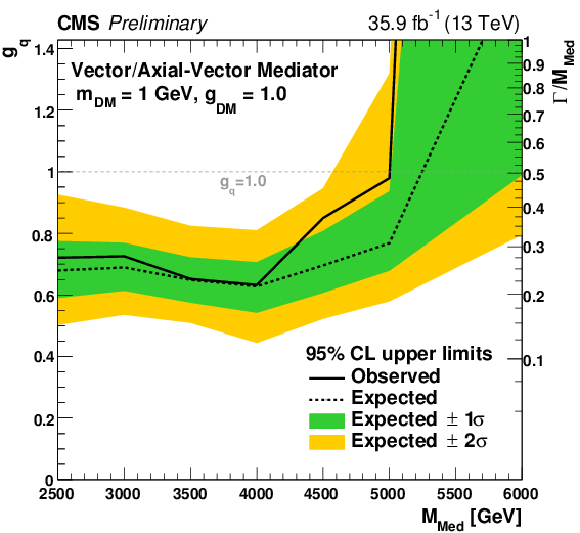
png pdf |
Figure 2:
The 95% CL upper limits on the universal quark coupling $g_{\text {q}}$ as a function of mass for a leptophobic axial-vector or vector DM mediator with $g_{\text {DM}}=1.0$ and $m_{\text {DM}}= $ 1 GeV. The observed limits (solid), expected limits (dashed) and their variation at the 1 and 2 standard deviation levels (shaded bands) are shown. A dotted horizontal line shows the coupling strength for a benchmark DM mediator with $g_{\text {q}}=1.0$. |
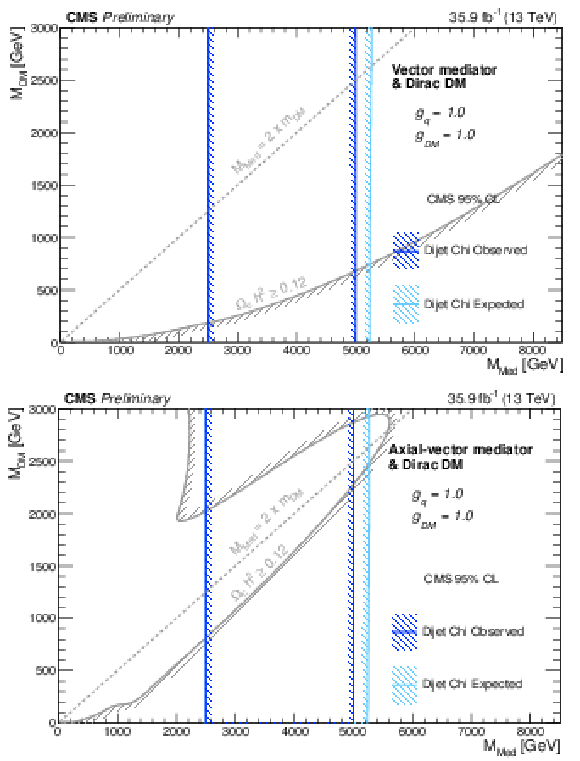
png pdf |
Figure 3:
The 95% CL observed (blue) and expected (light blue) excluded regions in the plane of dark matter mass vs. mediator mass, for a (top) vector mediator and an (bottom) axial-vector mediator for a DM benchmark model with $g_{\text {DM}}=1.0$ and $g_{\text {q}}=1.0$ are compared to constraints from the cosmological relic density of DM (light gray) determined from astrophysical measurements and MadDM version 2.0.6 [65,66]. |

png pdf |
Figure 3-a:
The 95% CL observed (blue) and expected (light blue) excluded regions in the plane of dark matter mass vs. mediator mass, for a vector mediator for a DM benchmark model with $g_{\text {DM}}=1.0$ and $g_{\text {q}}=1.0$ are compared to constraints from the cosmological relic density of DM (light gray) determined from astrophysical measurements and MadDM version 2.0.6 [65,66]. |
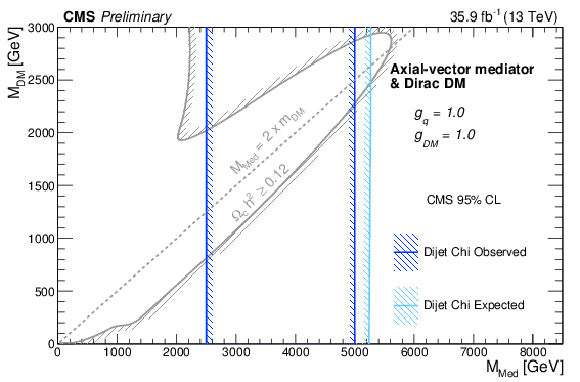
png pdf |
Figure 3-b:
The 95% CL observed (blue) and expected (light blue) excluded regions in the plane of dark matter mass vs. mediator mass, for a axial-vector mediator for a DM benchmark model with $g_{\text {DM}}=1.0$ and $g_{\text {q}}=1.0$ are compared to constraints from the cosmological relic density of DM (light gray) determined from astrophysical measurements and MadDM version 2.0.6 [65,66]. |
| Tables | |
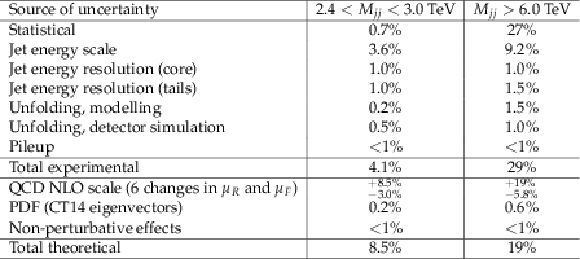
png pdf |
Table 1:
Summary of leading experimental and theoretical uncertainties on the normalized $ {\chi _{\text {dijet}}} $ distributions in %. While the statistical analysis represents each uncertainty through a change in the $ {\chi _{\text {dijet}}} $ distribution correlated among all $ {\chi _{\text {dijet}}} $ bins, this table summarizes each uncertainty by a representative percentage to demonstrate the relative contributions. For the lowest and highest dijet mass bins, the relative shift is given for the lowest $ {\chi _{\text {dijet}}} $ bin. In the highest dijet mass bin, the dominant experimental contribution corresponds to the statistical uncertainty, while the dominant theoretical contribution is from the uncertainty in QCD scales. |

png pdf |
Table 2:
Observed and expected exclusion limits at 95% CL for various CI, ADD, QBH, and DM models. The 68% ranges of expectation for the expected limit are given as well. For the DM vector mediator, couplings $g_{\text {DM}}=1$, $g_{\text {q}}=1$ and a DM mass of 1GeV are assumed and a range of masses instead of a lower limit is quoted. |
| Summary |
| Normalized dijet angular distributions have been measured with the CMS detector over a wide range of dijet invariant masses. The distributions are found to be in agreement with predictions of perturbative quantum chromodynamics and are used to set lower limits on the contact interaction scale for a variety of quark compositeness models, extra spatial dimensions, quantum black hole production, and simplified models of a quark and dark matter interactions. For the first time, a lower limit at the 95% confidence level of $g_{\text{q}}>1$ on the universal quark coupling of a dark matter mediator with masses between 2.5 and 5.0 TeV for (axial-)vector mediators is set in a region that is not accessible through dijet resonance searches. The lower limits for the contact interaction scale $\Lambda$ range from 9.1 to 22.2 TeV. The lower limits for the scales of ADD models, $\Lambda_{\mathrm{T}}$ (GRW) and $M_{\mathrm{S}}$ (HLZ), are in the range of 8.9-12.6 TeV, and are the most stringent set of limits available. Quantum black hole production scales in the ADD $n_{\textrm{ED}} = $ 6 model of up to 8.3 TeV and in the Randall-Sundrum $n_{\textrm{ED}}= $ 1 model of up to 6.0 TeV are excluded. |
| Additional Figures | |
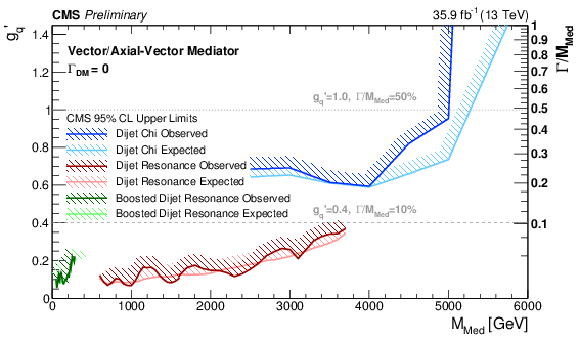
png pdf |
Additional Figure 1:
The 95% CL upper limits on the universal quark coupling $g_{\text {q}}'$ as a function of the mass of a DM mediator that only decays to quarks from CMS dijet narrow resonance search (CMS-PAS-EXO-16-056), boosted dijet resonance search (CMS-PAS-EXO-17-001), and dijet chi analysis (CMS-PAS-EXO-16-046) with 35.9 fb$^{-1}$. The red and light red lines correspond to the observed and expected limits from the dijet narrow resonance search. The green and light green lines correspond to the observed and expected limits from the boosted dijet resonance search. A dashed horizontal line at $g_{\text {q}}'=$ 0.4 indicates the lower border of the region for which the resonance width is $>$ 10% such that the sensitivity for the dijet resonance searches might fade away. The blue and light blue lines correspond to the observed and expected limits from the dijet chi analysis. A dotted horizontal line shows the coupling strength $g_{\text {q}}'= $ 1.0, which is the benchmark quark coupling chosen by the dijet chi analysis. |

png pdf |
Additional Figure 2:
Same as Fig.-aux 1 but with log scale for the x-axis. |
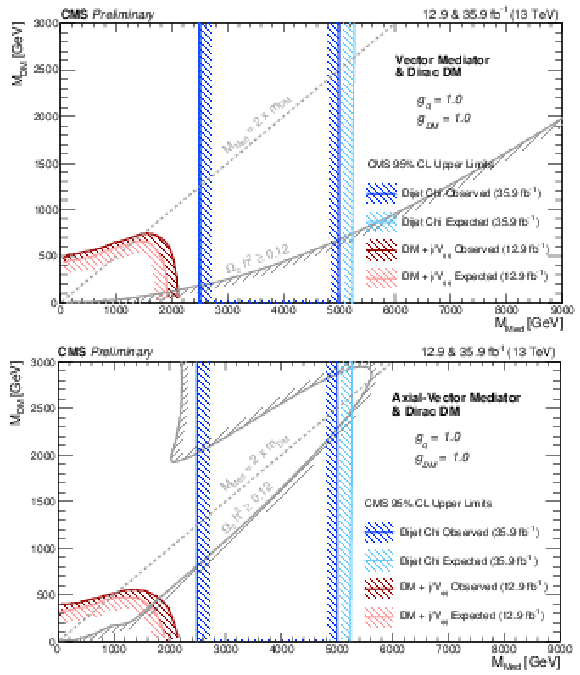
png pdf |
Additional Figure 3:
The 95% CL observed (blue) and expected (light blue) exclusion regions in the plane of dark matter mass vs. mediator mass, for a (top) vector mediator and an (bottom) axial-vector mediator for a DM benchmark model with $g_{\text {DM}}=$ 1.0 and $g_{\text {q}}= $ 1.0, are compared to constraints from the cosmological relic density of DM (light gray) determined from astrophysical measurements. The exclusion regions are also compared to the 95% CL observed (red) and expected (light red) exclusion regions from the CMS monojet search with 12.9 fb$^{-1}$ (CMS-EXO-16-037). |
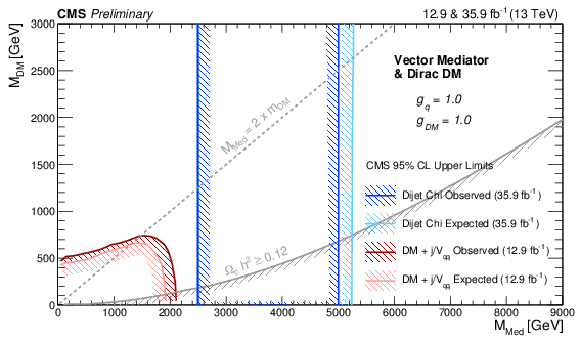
png pdf |
Additional Figure 3-a:
The 95% CL observed (blue) and expected (light blue) exclusion regions in the plane of dark matter mass vs. mediator mass, for a vector mediator for a DM benchmark model with $g_{\text {DM}}=$ 1.0 and $g_{\text {q}}= $ 1.0, are compared to constraints from the cosmological relic density of DM (light gray) determined from astrophysical measurements. The exclusion regions are also compared to the 95% CL observed (red) and expected (light red) exclusion regions from the CMS monojet search with 12.9 fb$^{-1}$ (CMS-EXO-16-037). |

png pdf |
Additional Figure 3-b:
The 95% CL observed (blue) and expected (light blue) exclusion regions in the plane of dark matter mass vs. mediator mass, for an axial-vector mediator for a DM benchmark model with $g_{\text {DM}}=$ 1.0 and $g_{\text {q}}= $ 1.0, are compared to constraints from the cosmological relic density of DM (light gray) determined from astrophysical measurements. The exclusion regions are also compared to the 95% CL observed (red) and expected (light red) exclusion regions from the CMS monojet search with 12.9 fb$^{-1}$ (CMS-EXO-16-037). |
| References | ||||
| 1 | M. Chala et al. | Constraining Dark Sectors with Monojets and Dijets | JHEP 07 (2015) 089 | 1503.05916 |
| 2 | ATLAS Collaboration | Search for new phenomena in dijet events using 37 fb$ ^{-1} $ of $ pp $ collision data collected at $ \sqrt{s}= $13 TeV with the ATLAS detector | submitted to PRD (2017) | 1703.09127 |
| 3 | CMS Collaboration | Search for dijet resonances in proton-proton collisions at $ \sqrt{s} = $ 13 TeV and constraints on dark matter and other models | PLB (2016) | CMS-EXO-16-032 1611.03568 |
| 4 | H. Dreiner, D. Schmeier, and J. Tattersall | Contact Interactions Probe Effective Dark Matter Models at the LHC | Europhys. Lett. 102 (2013), no. 5, 51001 | 1303.3348 |
| 5 | B. L. Combridge and C. J. Maxwell | Untangling Large p(T) Hadronic Reactions | Nucl. Phys. B239 (1984) 429 | |
| 6 | CMS Collaboration | Search for new physics with dijet angular distributions in proton-proton collisions at $ \sqrt{s} = $ 13 TeV | submitted to JHEP (2017) | CMS-EXO-15-009 1703.09986 |
| 7 | J. Abdallah et al. | Simplified Models for Dark Matter Searches at the LHC | Phys. Dark Univ. 9-10 (2015) 8--23 | 1506.03116 |
| 8 | G. Busoni et al. | Recommendations on presenting LHC searches for missing transverse energy signals using simplified $ s $-channel models of dark matter | 1603.04156 | |
| 9 | CMS Collaboration Collaboration | Searches for dijet resonances in pp collisions at $ \sqrt{s}= $ 13 TeV using data collected in 2016. | Technical Report CMS-PAS-EXO-16-056, CERN, Geneva | |
| 10 | ATLAS Collaboration | Search for new phenomena in final states with an energetic jet and large missing transverse momentum in $ pp $ collisions at $ \sqrt{s}=$ 13 TeV using the ATLAS detector | PRD 94 (2016), no. 3, 032005 | 1604.07773 |
| 11 | CMS Collaboration | Search for dark matter produced with an energetic jet or a hadronically decaying W or Z boson at $ \sqrt{s} = $ 13 TeV | submitted to JHEP (2017) | CMS-EXO-16-037 1703.01651 |
| 12 | CMS Collaboration Collaboration | Search for new physics in final states with an energetic jet or a hadronically decaying W or Z boson using 35.9 fb$^{-1}$ of data at $ \sqrt{s} = $ 13 TeV | CMS-PAS-EXO-16-048 | |
| 13 | H. Terazawa | Subquark model of leptons and quarks | PRD 22 (1980) 184 | |
| 14 | E. Eichten, K. Lane, and M. Peskin | New tests for quark and lepton substructure | PRL 50 (1983) 811 | |
| 15 | E. Eichten et al. | Supercollider physics | Rev. Mod. Phys. 56 (1984) 579 | |
| 16 | CMS Collaboration | Search for contact interactions using the inclusive jet $ p_{T} $ spectrum in pp collisions at $ \sqrt{s}= $ 7 TeV | PRD 87 (2013) 052017 | CMS-EXO-11-010 1301.5023 |
| 17 | N. Arkani-Hamed, S. Dimopoulos, and G. Dvali | The hierarchy problem and new dimensions at a millimeter | PLB 429 (1998) 263 | hep-ph/9803315 |
| 18 | N. Arkani-Hamed, S. Dimopoulos, and G. Dvali | Phenomenology, astrophysics and cosmology of theories with sub-millimeter dimensions and tev scale quantum gravity | PRD 59 (1999) 086004 | hep-ph/9807344 |
| 19 | P.C. Argyres, S. Dimopoulos and J. March-Russell | Black holes and sub-millimeter dimensions | PLB 441 (1998) 96 | hep-th/9808138 |
| 20 | T. Banks and W. Fischler | A Model for high-energy scattering in quantum gravity | hep-th/9906038 | |
| 21 | R. Emparan, G. T. Horowitz, and R. C. Myers | Black holes radiate mainly on the brane | PRL 85 (2000) 499--502 | hep-th/0003118 |
| 22 | S. Dimopoulos and G.L. Landsberg | Black holes at the lhc | PRL 87 (2001) 161602 | hep-ph/0106295 |
| 23 | S.B. Giddings and S.D. Thomas | High energy colliders as black hole factories: the end of short distance physics | PRD 65 (2002) 056010 | hep-ph/0106219 |
| 24 | X. Calmet, W. Gong, and S. D. H. Hsu | Colorful quantum black holes at the lhc | "PLB" 668 (2008) 20 | 0806.4605 |
| 25 | P. Meade, L. Randall | Black holes and quantum gravity at the lhc | JHEP 05 (2008) 003 | 0708.3017 |
| 26 | D. M. Gingrich | Quantum black holes with charge, colour, and spin at the lhc | JPG 37 (2010) 105008 | 0912.0826 |
| 27 | CMS Collaboration | Search for resonances and quantum black holes using dijet mass spectra in proton-proton collisions at $ \sqrt{s}= $ 8 TeV | PRD 91 (2015) 052009 | CMS-EXO-12-059 1501.04198 |
| 28 | CMS Collaboration | The cms experiment at the cern lhc | JINST 3 (2008) S08004 | CMS-00-001 |
| 29 | CMS Collaboration | Particle-flow reconstruction and global event description with the CMS detector | Submitted to JINST | CMS-PRF-14-001 1706.04965 |
| 30 | M. Cacciari, G. P. Salam, and G. Soyez | The anti-kt Jet Clustering Algorithm | JHEP 04 (2008) 063 | 0802.1189 |
| 31 | CMS Collaboration | Jet energy scale and resolution in the CMS experiment in pp collisions at 8 TeV | JINST 12 (2017), no. 02, P02014 | CMS-JME-13-004 1607.03663 |
| 32 | T. Sj\"ostrand, S. Mrenna, and P. Skands | PYTHIA 6.4 physics and manual | JHEP 05 (2006) 026 | hep-ph/0603175 |
| 33 | T. Sj\"ostrand, S. Mrenna, and P. Skands | A brief Introduction to PYTHIA 8.1 | Comput. Phys. Comm. 178 (2008) 852 | 0710.3820 |
| 34 | CMS Collaboration | The CMS trigger system | JINST 12 (2017), no. 01, P01020 | CMS-TRG-12-001 1609.02366 |
| 35 | CMS Collaboration | Description and performance of track and primary-vertex reconstruction with the CMS tracker | JINST 9 (2014), no. 10, P10009 | CMS-TRK-11-001 1405.6569 |
| 36 | CMS Collaboration | Jets in 0.9 and 2.36 tev pp collisions | CDS | |
| 37 | G. D'Agostini | A multidimensional unfolding method based on bayes' theorem | NIMA 362 (1995), no. 23, 487 | |
| 38 | T. Adye | Unfolding algorithms and tests using RooUnfold | in Proceedings, PHYSTAT 2011 Workshop on Statistical Issues Related to Discovery Claims in Search Experiments and Unfolding, CERN 2011 | 1105.1160CERN-2011-006.313 |
| 39 | M. Oreglia | PhD thesis, SLAC | ||
| 40 | CMS Collaboration | Jet energy scale and resolution performances with 13 TeV data | CDS | |
| 41 | GEANT4 Collaboration | GEANT4---a simulation toolkit | NIMA 506 (2003) 250 | |
| 42 | J. Alwall et al. | The automated computation of tree-level and next-to-leading order differential cross sections, and their matching to parton shower simulations | JHEP 07 (2014) 079 | 1405.0301 |
| 43 | Z. Nagy | Three-jet cross sections in hadron hadron collisions at next-to-leading order | PRL 88 (2002) 122003 | hep-ph/0110315 |
| 44 | T. Kluge, K. Rabbertz, and M. Wobisch | Fast pQCD calculations for PDF fits | in DIS 2006, 20-24 Apr 2006, p. 483 Tsukuba, Japan, April | hep-ph/0609285 |
| 45 | S. Dittmaier, A. Huss, and C. Speckner | Weak radiative corrections to dijet production at hadron colliders | JHEP 11 (2012) 095 | 1210.0438 |
| 46 | S. Dulat et al. | New parton distribution functions from a global analysis of quantum chromodynamics | PRD 93 (2016) 033006 | 1506.07443 |
| 47 | J. Butterworth et al. | PDF4LHC recommendations for LHC run II | JPG 43 (2016) 023001 | 1510.03865 |
| 48 | L. A. Harland-Lang, A. D. Martin, P. Motylinski, and R. S. Thorne | Parton distributions in the LHC era: MMHT 2014 PDFs | EPJC 75 (2015) 204 | 1412.3989 |
| 49 | NNPDF Collaboration | Parton distributions for the LHC run II | JHEP 04 (2015) 040 | 1410.8849 |
| 50 | J. Gao and P. Nadolsky | A meta-analysis of parton distribution functions | JHEP 07 (2014) 035 | 1401.0013 |
| 51 | S. Carrazza et al. | An unbiased hessian representation for Monte Carlo PDFs | EPJC 75 (2015) 369 | 1505.06736 |
| 52 | P. Skands, S. Carrazza, and J. Rojo | Tuning PYTHIA 8.1: the Monash 2013 Tune | EPJC 74 (2014) 3024 | 1404.5630 |
| 53 | CMS Collaboration | Event generator tunes obtained from underlying event and multiparton scattering measurements | EPJC 76 (2016) 155 | CMS-GEN-14-001 1512.00815 |
| 54 | M. Bahr and et al. | Herwig++ physics and manual | EPJC 58 (2008) 639 | 0803.0883 |
| 55 | M. Cacciari et al. | The t anti-t cross-section at 1.8 TeV and 1.96 TeV: A study of the systematics due to parton densities and scale dependence | JHEP 04 (2004) 068 | hep-ph/0303085 |
| 56 | A. Banfi, G. P. Salam, and G. Zanderighi | Phenomenology of event shapes at hadron colliders | JHEP 06 (2010) 038 | 1001.4082 |
| 57 | P. M. Nadolsky et al. | Implications of CTEQ global analysis for collider observables | PRD 78 (2008) 013004 | 0802.0007 |
| 58 | J. Gao et al. | Next-to-leading QCD effect to the quark compositeness search at the LHC | PRL 106 (2011) 142001 | 1101.4611 |
| 59 | G. Giudice, R. Rattazzi, and J. Wells | Quantum gravity and extra dimensions at high-energy colliders | Nucl. Phys. B 544 (1999) 3 | hep-ph/9811291 |
| 60 | T. Han, J. Lykken, and R. Zhang | On kaluza-klein states from large extra dimensions | PRD 59 (1999) 105006 | hep-ph/9811350 |
| 61 | K. Cheung and G. Landsberg | Drell-Yan and diphoton production at hadron colliders and low scale gravity model | PRD 62 (2000) 076003 | hep-ph/9909218 |
| 62 | L. Randall, R. Sundrum | Large mass hierarchy from a small extra dimension | PRL 83 (1999) 3370 | hep-ph/9905221 |
| 63 | L. Randall, R. Sundrum | An alternative to compactification | PRL 83 (1999) 4690 | hep-th/9906064 |
| 64 | D. M. Gingrich | Monte carlo event generator for black hole production and decay in proton-proton collisions | CPC 181 (2010) 1917 | 0911.5370 |
| 65 | M. Backovic, K. Kong, and M. McCaskey | MadDM v.1.0: Computation of Dark Matter Relic Abundance Using MadGraph5 | Physics of the Dark Universe 5-6 (2014) 18--28 | 1308.4955 |
| 66 | M. Backović et al. | Direct Detection of Dark Matter with MadDM v.2.0 | Phys. Dark Univ. 9-10 (2015) 37--50 | 1505.04190 |
| 67 | G. Cowan, K. Cranmer, E. Gross, and O. Vitells | Asymptotic formulae for likelihood-based tests of new physics | EPJC 71 (2011) 1554 | 1007.1727 |
| 68 | T. Junk | Confidence level computation for combining searches with small statistics | NIMA 434 (1999) 435 | hep-ex/9902006 |
| 69 | A. L. Read | Presentation of search results: The CL(s) technique | JPG28 (2002) 2693 | |

|
Compact Muon Solenoid LHC, CERN |

|

|

|

|

|

|